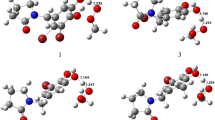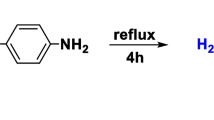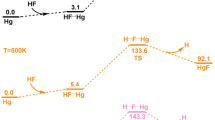Abstract
Irradiation of 2-nitrobenzyl alcohol (1, R = H) and 1-(2-nitrophenyl)ethanol (1, R = Me) in various solvents yields 2-nitroso benzaldehyde (4, R = H) and 2-nitroso acetophenone (4, R = Me), respectively, with quantum yields of about 60%. The mechanism of this reaction, known since 1918, was investigated using laser flash photolysis, time-resolved infrared spectroscopy (TRIR), and 18O-labeling experiments. The primary aci-nitro photoproducts 2 react by two competing paths. The balance between the two depends on the reaction medium. Reaction via hydrated nitroso compounds 3 formed by proton transfer prevails in aprotic solvents and in aqueous acid and base. In water, pH 3–8, the classical mechanism of cyclization to benzisoxazolidine intermediates 5, followed by ring opening to carbonyl hydrates 6, predominates. The transient intermediates 3 and 6 were identified by TRIR. Potential energy surfaces for these reactions were mapped by density functional calculations.
Similar content being viewed by others
References
C. G. Bochet, Photolabile protecting groups and linkers, J. Chem. Soc., Perkin Trans. 1, 2002, 2002, 125–142.
A. P. Pelliccioli and J. Wirz, Photoremovable protecting groups: reaction mechanisms and applications, Photochem. Photobiol. Sci., 2002, 1, 441–458.
Y. V. Il’ichev, M. A. Schwörer and J. Wirz, Photochemical reaction mechanisms of 2-nitrobenzyl compounds: methyl ethers and caged ATP, J. Am. Chem. Soc., 2004, 126, 4581–4595.
E. Bamberger, Photochemische Bildungsweise des o-Nitrosobenzaldehyds, Ber., 1918, 51, 606–612.
S. R. Adams, J. P. Y. Kao, G. Grynkiewicz, A. Minta and R. Y. Tsien, Biologically useful chelators that release Ca2+ upon illumination, J. Am. Chem. Soc., 1988, 110, 3212–3220.
G. Gauglitz and S. Hubig, Photokinetische Grundlagen moderner chemischer Aktinometer, Z. Phys. Chem. (Munich), 1984, 139, 237–246.
G. Gauglitz and S. Hubig, Chemical actinometry in the UV by azobenzene in concentrated solution: A convenient method, J. Photochem., 1985, 30, 121–125.
G. Persy and J. Wirz, Spectrophotometric actinometry with azobenzene, EPA Newslett., 1987, 29, 45–46.
S. A. Kovalenko, A. L. Dobryakov, J. Ruthmann and N. P. Ernsting, Femtosecond spectroscopy of condensed phases with chirped supercontinuum probing, Phys. Rev. A, 1999, 59, 2369–2384.
J. H. Kaplan, B. Forbush and J. F. Hoffman, Rapid photolytic release of adenosine 5′-triphosphate from a protected analogue: utilization by the Na:K pump of human red blood cell ghosts, Biochemistry, 1978, 17, 1929–1935.
M. J. Frisch, G. W. Trucks, H. B. Schlegel, G. E. Scuseria, M. A. Robb, J. R. Cheeseman, V. G. Zakrzewski, J. A. Montgomery, Jr., R. E. Stratmann, J. C. Burant, S. Dapprich, J. M. Millam, A. D. Daniels, K. N. Kudin, M. C. Strain, O. Farkas, J. Tomasi, V. Barone, M. Cossi, R. Cammi, B. Mennucci, C. Pomelli, C. Adamo, S. Clifford, J. Ochterski, G. A. Petersson, P. Y. Ayala, Q. Cui, K. Morokuma, P. Salvador, J. J. Dannenberg, D. K. Malick, A. D. Rabuck, K. Raghavachari, J. B. Foresman, J. Cioslowski, J. V. Ortiz, A. G. Baboul, B. B. Stefanov, G. Liu, A. Liashenko, P. Piskorz, I. Komaromi, R. Gomperts, R. L. Martin, D. J. Fox, T. Keith, M. A. Al-Laham, C. Y. Peng, A. Nanayakkara, M. Challacombe, P. M. W. Gill, B. G. Johnson, W. Chen, M. W. Wong, J. L. Andres, C. Gonzalez, M. Head-Gordon, E. S. Replogle and J. A. Pople, GAUSSIAN 98 (Revision A.11), Gaussian, Inc., Pittsburgh, PA, 2001.
A. P. Scott and L. Radom, Harmonic vibrational frequencies: an evaluation of Hartree–Fock, Møller–Plesset, quadratic configuration interaction, density functional theory, and semiempirical scale factors, Phys. Chem., 1996, 100, 16502–16513.
Y. V. Il’ichev and J. Wirz, Rearrangements of nitrobenzyl compounds. 1. Potential energy surface of 2-nitrotoluene and its isomers explored with ab initio and density functional theory methods, J. Phys. Chem. A, 2000, 104, 7856–7870.
Y. V. Il’ichev, Rearrangements of nitrobenzyl compounds. 2. Substituent effects on the reactions of the quinonoid intermediates, J. Phys. Chem. A, 2003, 107, 10159–10170.
M. Cossi, V. Barone, R. Cammi and J. Tomasi, Ab initio study of solvated molecules: a new implementation of the polarizable continuum model, Chem. Phys. Lett., 1996, 255, 327–335.
J. R. Pliego, Jr. and J. M. Riveros, Theoretical calculation of pKa using the cluster–continuum model, J. Phys. Chem., 2002, 106, 7434–7439.
M. Schwörer and J. Wirz, 2-Nitrotoluene: thermodynamic and kinetic parameters of the aci-tautomer, Helv. Chim. Acta, 2001, 84, 1441–1458.
M. E. Casida, C. Jamorski, K. C. Casida and D. R. Salahub, Molecular excitation energies to high-lying bound states from time-dependent density-functional response theory: Characterization and correction of the time-dependent local density approximation ionization threshold, J. Chem. Phys., 1998, 108, 4439–4449.
A. Barth, J. E. T. Corrie, M. J. Gradwell, Y. Maeda, W. Mäntele, T. Meier and D. R. Trentham, Time-resolved infrared spectroscopy of intermediates and products from photolysis of 1-(2-nitrophenyl)ethyl phosphates: reaction of the 2-nitrosoacetophenone byproduct with thiols, J. Am. Chem. Soc., 1997, 119, 4149–4159.
R. A. McClelland and M. Coe, Structure-reactivity effects in the hydration of benzaldehydes, J. Am. Chem. Soc., 1983, 105, 2718–2725.
The extinction coefficient of o-benzoquinone is ε390 = 2200 M−1 cm−1 )S. Goldschmidt and F. Graef, Optische Untersuchungen an Chinonen und freien Radikalen, Ber., 1928, 61, 1858–1869)
that of 2,2-dimethylisoindene is ε400 = 3060 M−1 cm−1 (; M. Allan, K. R. Asmis, S. El houar, E. Haselbach, M. Capponi, B. Urwyler and J. Wirz, Triplet energy of 2,2-dimethylisoindene from electron-energy-loss spectroscopy and photoinduced triplet energy transfer, Helv. Chim. Acta, 1994, 77, 1541–1548).
Excitation of compounds 1 at 248 nm in aqueous base formed an additional, unidentified intermediate with absorption overlapping the aci-nitro transients 2. This complication was avoided by excitation with 308 nm pulses from the excimer laser operating on XeCl.
R. G. Bates, Determination of pH. Theory and Practice, Wiley, New York, 1973.
Calculated frequencies are available as supplementary material. The predicted band positions and intensities for the four isomers were too similar to warrant an identification of the observed geometrical isomer(s) of 2.
A potential energy minimum was found for EZ-2, but the energy of the transition state was lower than that of EZ-2 after correcting for the zero-point energies.
The rate of formation of the aci-transients may depend on the wavelength of excitation: A. Blanc and C. Bochet, Isotope effects in photochemistry. 1. o-Nitrobenzyl alcohol derivatives, J. Am. Chem. Soc., 2004, 126, 7174–7175. Compound 1 (R = Me) was excited at 270 nm in this pump–probe experiment.
If the excited-state proton transfer occurs adiabatically from triplet 1 yielding the triplet state of the aci-intermediate, then isomerization around the C-N bond might occur: R. Haag, J. Wirz and P. J. Wagner, The photoenolization of 2-methylacetophenone and related compounds, Helv. Chim. Acta, 1977, 60, 259-2607. However, formation of the aci-transient within 1 ps suggests that the reaction proceeds from the excited singlet state of 1 to yield the ground state aci-intermediate 2 through a conical intersection.
P. Zuman, Additions of water, hydroxyde ion, alcohols and alkoxide ions to carbonyl and azomethine bonds, ARKIVOC, 2002, 85–140,. http://www.arkat-usa.org/ark/journal/2002/General/2-540R/540R.asp.
G. M. Loudon, Mechanistic interpretation of pH–rate profiles, J. Chem. Educ., 1991, 68, 973–984.
W. Grünbein and A. Henglein, Pulsradiolytische Untersuchung zweibasischer Radikale der Reduktion von Nitrophenolen in wässriger Lösung, Ber. Bunsen-Ges., 1969, 73, 376–382.
W. Grünbein, A. Fojtik and A. Henglein, Pulsradiolytische Untersuchung kurzlebiger Hydrate von aromatischen Nitrosoverbindungen, Monatsh. Chem., 1970, 101, 1243–1252.
P. Wan and K. Yates, Photoredox chemistry of nitrobenzyl alcohols in aqueous solution. Acid and base catalysis reaction, Can. J. Chem., 1986, 64, 2076–2086.
M. V. George and J. C. Scaiano, Photochemistry of o-nitrobenzaldehyde and related studies, J. Phys. Chem., 1980, 84, 492–495.
Author information
Authors and Affiliations
Corresponding author
Additional information
Dedicated to Professor Hiroshi Masuhara on the occasion of his 60th birthday.
Electronic supplementary information (ESI) available: Coordinates and energies of all optimised structures, original rate data and calculated frequencies. See http://www.rsc.org/suppdata/pp/b4/b409927c/
Rights and permissions
About this article
Cite this article
Gaplovsky, M., Il’ichev, Y.V., Kamdzhilov, Y. et al. Photochemical reaction mechanisms of 2-nitrobenzyl compounds: 2-Nitrobenzyl alcohols form 2-nitroso hydrates by dual proton transfer. Photochem Photobiol Sci 4, 33–42 (2005). https://doi.org/10.1039/b409927c
Received:
Accepted:
Published:
Issue Date:
DOI: https://doi.org/10.1039/b409927c




